
Spyridium parvifolium, commonly known dusty miller, is a flowering plant in the family Rhamnaceae. It has dark green leaves and clusters of small, whitish flowers at the end of branches. It is widespread in eastern states of Australia.
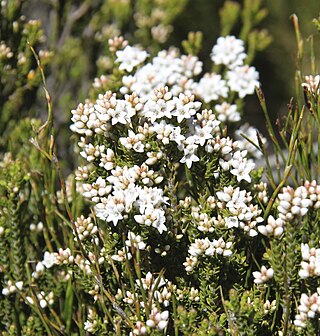
Epacris glacialis, commonly known as reddish bog-heath, is a species of flowering plant in the family Ericaceae and is endemic to south-eastern continental Australia. It is a prostrate to low-lying shrub with crowded, rhombus-shaped to broadly egg-shaped leaves with the narrower end towards the base, and tube-shaped, white flowers in small clusters near the ends of the branches.
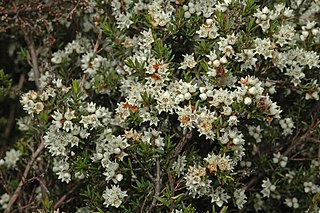
Cryptandra tomentosa, commonly known as prickly cryptandra, is a species of flowering plant in the family Rhamnaceae and is endemic to the southern continental Australia. It is a small, straggling, erect to low-lying shrub sometimes with spiny branches, and has cylindrical leaves and loose clusters of white, bell-shaped flowers that turn pink to red as they age.

Prostanthera decussata, commonly known as dense mintbush, species of flowering plant that is endemic south-eastern Australia. It is a dense, compact, strongly aromatic shrub with egg-shaped leaves and mauve to violet flowers with yellow streaks, arranged in leaf axils near the ends of branchlets.
Persoonia brachystylis is a species of flowering plant in the family Proteaceae and is endemic to a restricted area on the west coast of Western Australia. It is an erect, spreading shrub with smooth bark, narrow spatula-shaped to lance-shaped leaves and yellow flowers in groups of ten to twenty.

Grevillea eriobotrya, commonly called the woolly cluster grevillea, is a species of flowering plant in the family Proteaceae and is endemic to a small area in the south-west of Western Australia. It is dense, erect, spreading shrub usually with linear leaves, and groups of white to creamy-white flowers.

Olearia magniflora, commonly known as splendid daisy-bush, is a small shrub with clusters of deep mauve to purple flowers.

Bossiaea decumbens is a spreading, prostrate shrub in the pea family (Fabaceae), and is endemic to Victoria. It has alternate, variable shaped leaves and yellow pea flowers with red splotches from spring to late summer.

Prostanthera canaliculata is a species of flowering plant in the family Lamiaceae and is endemic to the south-west of Western Australia. It is a small, erect shrub with hairy branchlets, narrow egg-shaped to narrow elliptical leaves and pale blue or pale violet to white flowers with no markings.

Stachystemon polyandrus is a species of flowering plant in the family Picrodendraceae and is endemic to the southwest of Western Australia. It is a diffuse to straggling, monoecious shrub with crowded, oblong, elliptic or egg-shaped leaves with the narrower end towards the base, and small yellowish-white flowers arranged singly in upper leaf axils, but forming clusters at the ends of branches.
Pomaderris forrestiana is a species of flowering plant in the family Rhamnaceae and is endemic to south-western Australia. It is a low shrub with elliptic leaves, and small clusters of woolly-hairy flowers.
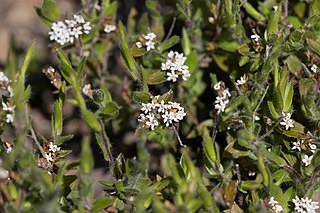
Leucopogon concurvus is a species of flowering plant in the heath family Ericaceae and is endemic to a restricted part of South Australia. It is a slender shrub with egg-shaped leaves, and white, tube-shaped flowers arranged along the branches.
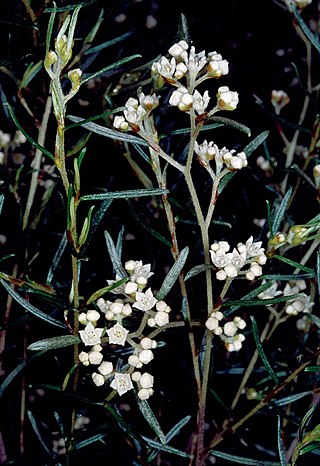
Spyridium waterhousei is a species of flowering plant in the family Rhamnaceae and is endemic to Kangaroo Island in South Australia. It is an erect, slightly sticky shrub with linear leaves and heads of hairy flowers with three brown bracts at the base.
Stenanthemum complicatum is a species of flowering plant in the family Rhamnaceae and is endemic to the southwest of Western Australia. It is a woody, erect or straggling shrub with densely hairy young stems, broadly egg-shaped leaves and densely woolly-hairy heads of tube-shaped flowers.
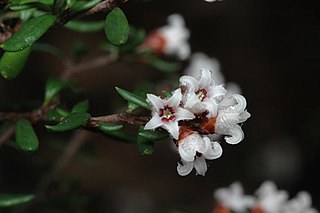
Cryptandra lanosiflora is a species of flowering plant in the family Rhamnaceae and is endemic to eastern Australia. It is a shrub with many branches, linear leaves, and hairy, white tube-shaped flowers.

Cryptandra longistaminea is a species of flowering plant in the family Rhamnaceae and is endemic to eastern Australia. It is a shrub with many branches, egg-shaped or elliptic to linear leaves, and clusters of white, tube-shaped flowers.

Stenanthemum pumilum is a species of flowering plant in the family Rhamnaceae and is endemic to the southwest of Western Australia. It is a low, compact shrub with hairy young stems, egg-shaped leaves, sometimes with the narrower end towards the base, and clusters of 10 to 30 white to creamy-white, woolly hairy, tube-shaped flowers.

Cryptandra spyridioides is a species of flowering plant in the family Rhamnaceae and is endemic to the south-west of Western Australia. It is a shrub that typically grows to a height of 10–80 cm (3.9–31.5 in) and has green and creamy-white to pink flowers from May to August. It was first formally described in 1862 by Ferdinand von Mueller in his Fragmenta Phytographiae Australiae. The specific epithet (spyridioides) means "sweeper", hence "Spyridium-like".

Commersonia magniflora is a species of flowering plant in the family Malvaceae and endemic to Australia. It is an erect shrub with wrinkled, narrowly oblong to elliptic or egg-shaped leaves, and deep pink flowers.
Pimelea sericostachya is a species of flowering plant in the family Thymelaeaceae and is endemic to Queensland. It is an undershrub or shrub with densely hairy young stems, narrowly elliptic leaves, and heads of yellow or pale yellow flowers.
















